Numerical Analysis of Pillar Stability in Longwall Mining of Two Adjacent Panels of an Inclined Coal Seam
Abstract
:1. Introduction
2. Case Study Site
3. Numerical Modeling
4. Results and Discussion
4.1. Stress–Strain Evolution
4.2. Numerical Approach to Evaluation of FoS
5. Conclusions
- (i)
- The inclination of the seam causes a strong stress–strain asymmetry;
- (ii)
- The formation of a larger damage zone dome is manifested in the vicinity of roadway III;
- (iii)
- Roadway III is probably more prone to the violation of its functional properties than roadway II;
- (iv)
- In order to maintain the stable state of the protective pillars and to increase the coal recovery ratio and the economic efficiency of the mine, a pillar’s W/H ratio should not fall below 11.
Author Contributions
Funding
Data Availability Statement
Acknowledgments
Conflicts of Interest
Nomenclature
| density | |
| pressure | |
| components of deviatoric stress tensor | |
| bulk and shear modulus | |
| components of inelastic strain tensor | |
| multiplier used in theory of plasticity | |
| plastic potential equation | |
| yield surface equation | |
| internal friction factor | |
| dilatancy factor | |
| the second invariant of deviatoric stress tensor | |
| reference and current values of cohesion | |
| time parameter of damage accumulation measure | |
| measure of damage |
Appendix A

References
- Shabanimashcool, M.; Li, C.C. A numerical study of stress changes in barrier pillars and a border area in a longwall coal mine. Int. J. Coal Geol. 2013, 106, 39–47. [Google Scholar] [CrossRef]
- Xie, J.-L.; Xu, J.-L. Effect of key stratum on the mining abutment pressure of a coal seam. Geosci. J. 2017, 21, 267–276. [Google Scholar] [CrossRef]
- Islavath, S.R.; Deb, D.; Kumar, H. Numerical analysis of a longwall mining cycle and development of a composite longwall index. Int. J. Rock Mech. Min. Sci. 2016, 89, 43–54. [Google Scholar] [CrossRef]
- Zhang, G.; Liang, S.; Tan, Y.; Xie, F.; Chen, S.; Jia, H. Numerical modeling for longwall pillar design: A case study from a typical longwall panel in China. J. Geophys. Eng. 2018, 15, 121–134. [Google Scholar] [CrossRef]
- Wilson, A.H.; Ashwin, D.P. Research into the determination of pillar size. Trans. Inst. Min. Eng. 1972, 131, 409–429. [Google Scholar]
- Salamon, M.D.G.; Munro, A.H. A study of the strength of coal pillars. J. South. Afr. Inst. Min. Metall. 1967, 2, 68–78. [Google Scholar]
- Medhurst, T.P.; Brown, E.T. A study of the mechanical behaviour of coal for pillar design. Int. J. Rock Mech. Min. Sci. 1998, 35, 1087–1105. [Google Scholar] [CrossRef]
- Salamon, M.D.G.; Ozbay, M.U.; Madden, B.J. Life and design of bord-and-pillar workings affected by pillar scaling. J. S. Afr. Inst. Min. Metall. 1998, 98, 135–145. [Google Scholar]
- Galvin, J.M.; Hebblewhite, B.K.; Salamon, M.D.G. UNSW coal pillar strength determinations for Australian and South African mining conditions. In Proceedings of the Second International Workshop on Coal Pillar Mechanics and Design, Vail, CO, USA, 6 June 1999; NIOSH: Pittsburgh, PA, USA, 1999. IC9448. [Google Scholar]
- Deng, J.; Yueb, Z.Q.; Tham, L.G.; Zhu, H.H. Pillar design by combing neural networks and reliability: A case study of the Feng Huangshan copper mine China. Int. J. Rock Mech. Min. Sci. 2003, 40, 585–599. [Google Scholar] [CrossRef]
- Hoek, E.; Martin, C.D. Fracture initiation and propagation in intact rock–A review. J. Rock Mech. Geotech. Eng. 2014, 6, 287–300. [Google Scholar] [CrossRef] [Green Version]
- Oparin, V.N. Zonal Disintegration of Rocks and Stability of Underground Workings; Publishing House of SB RAS: Novosibirsk, Russia, 2008; p. 278. (In Russian) [Google Scholar]
- Liu, S.; Wan, Z.; Zhang, Y.; Lu, S.; Ta, X.; Wu, Z. Research on evaluation and control technology of coal pillar stability based on the fracture digitization method. Measurement 2020, 158, 107713. [Google Scholar] [CrossRef]
- Griffiths, D.V.; Fenton, G.A.; Lemons, C.B. Probabilistic analyses of underground pillar stability. Int. J. Numer. Anal. Methods Geomech. 2002, 26, 775–791. [Google Scholar] [CrossRef]
- Ghasemi, E.; Shahriar, K.; Sharifzadeh, M.; Hashemolhosseini, H. Quantifying the uncertainty of pillar safety factor by Monte Carlo simulation-a case study. Arch. Min. Sci. 2010, 55, 623–635. [Google Scholar]
- Li, C.; Zhou, J.; Armaghani, D.J.; Li, X. Stability analysis of underground mine hard rock pillars via combination of finite difference methods, neural networks, and Monte Carlo simulation techniques. Undergr. Space 2021, 6, 379–395. [Google Scholar] [CrossRef]
- Idris, M.A.; Saiang, D.; Nordlund, E. Stochastic assessment of pillar stability at Laisvall mine using Artificial Neural Network. Tunn. Undergr. Space Technol. 2015, 49, 307–319. [Google Scholar] [CrossRef] [Green Version]
- Ding, H.; Li, G.; Dong, X.; Lin, Y. Prediction of Pillar Stability for Underground Mines Using the Stochastic Gradient Boosting Technique. IEEE Access 2018, 6, 69253–69264. [Google Scholar] [CrossRef]
- Ghasemi, E.; Kalhori, H.; Bagherpour, R. Stability assessment of hard rock pillars using two intelligent classification techniques: A comparative study. Tunn. Undergr. Space Technol. 2017, 68, 32–37. [Google Scholar] [CrossRef]
- Xia, Z.; Yao, Q.; Meng, G.; Xu, Q.; Tang, C.; Zhu, L.; Wang, W.; Shen, Q. Numerical study of stability of mining roadways with 6.0-m section coal pillars under influence of repeated mining. Int. J. Rock Mech. Min. Sci. 2021, 138, 104641. [Google Scholar] [CrossRef]
- Wang, P.; Zhao, J.; Chugh, Y.P.; Wang, Z. A Novel Longwall Mining Layout Approach for Extraction of Deep Coal Deposits. Minerals 2017, 7, 60. [Google Scholar] [CrossRef] [Green Version]
- Zhao, J.; Wang, P.; Su, Y. An Innovative Longwall Mining Technology in Tangshan Coal Mine, China. Minerals 2017, 7, 14. [Google Scholar] [CrossRef] [Green Version]
- Foroughi, M.H. Some Aspects of Coal Pillar Stability in Inclined Coal Seams. Ph.D. Thesis, Tehran University, Tehran, Iran, 1996. [Google Scholar]
- Eremin, M.; Esterhuizen, G.; Smolin, I. Numerical simulation of roof cavings in several Kuzbass mines using finite- difference continuum damage mechanics approach. Int. J. Min. Sci. Technol. 2020, 30, 157–166. [Google Scholar] [CrossRef] [PubMed]
- Jones, N.S. A review of the AMM and CMM resources in the Kuznetsk (Kuzbass) Coal Basin, Russia. Br. Geol. Surv. Intern. Rep. 2005, 48. [Google Scholar]
- Yavorskii, V.I. Geologiya Mestorozhdenii Uglya i Goryuchih Slancev SSSR. Tom 7. Kuznetsky, Gorlovsky Basseini i Drugie Ugolnie Mestorozhdeniya Zapadnoy Sibiri; Nedra: Moscow, Russia, 1969. (In Russian) [Google Scholar]
- Drucker, D.C.; Prager, W. Soil Mechanics and plastic analysis or limit design. Q. Appl. Math. 1952, 10, 157–165. [Google Scholar] [CrossRef]
- Stefanov, Y.P.; Evseev, V.D.; Bakeev, R.A. Numerical modelling of deformation and fracture in geomaterials. Phys. Mesomech. 2004, 7, 265–268. [Google Scholar]
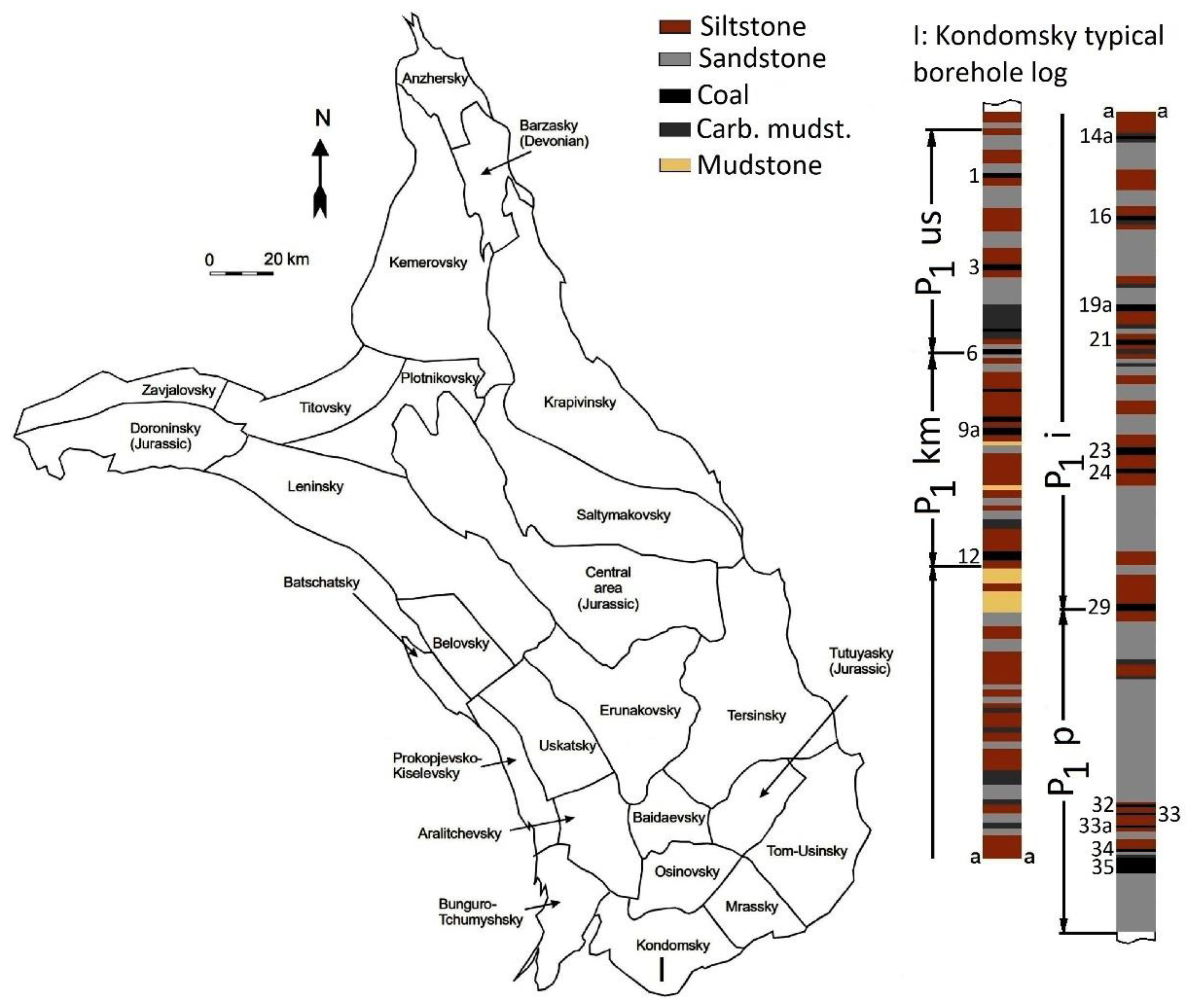
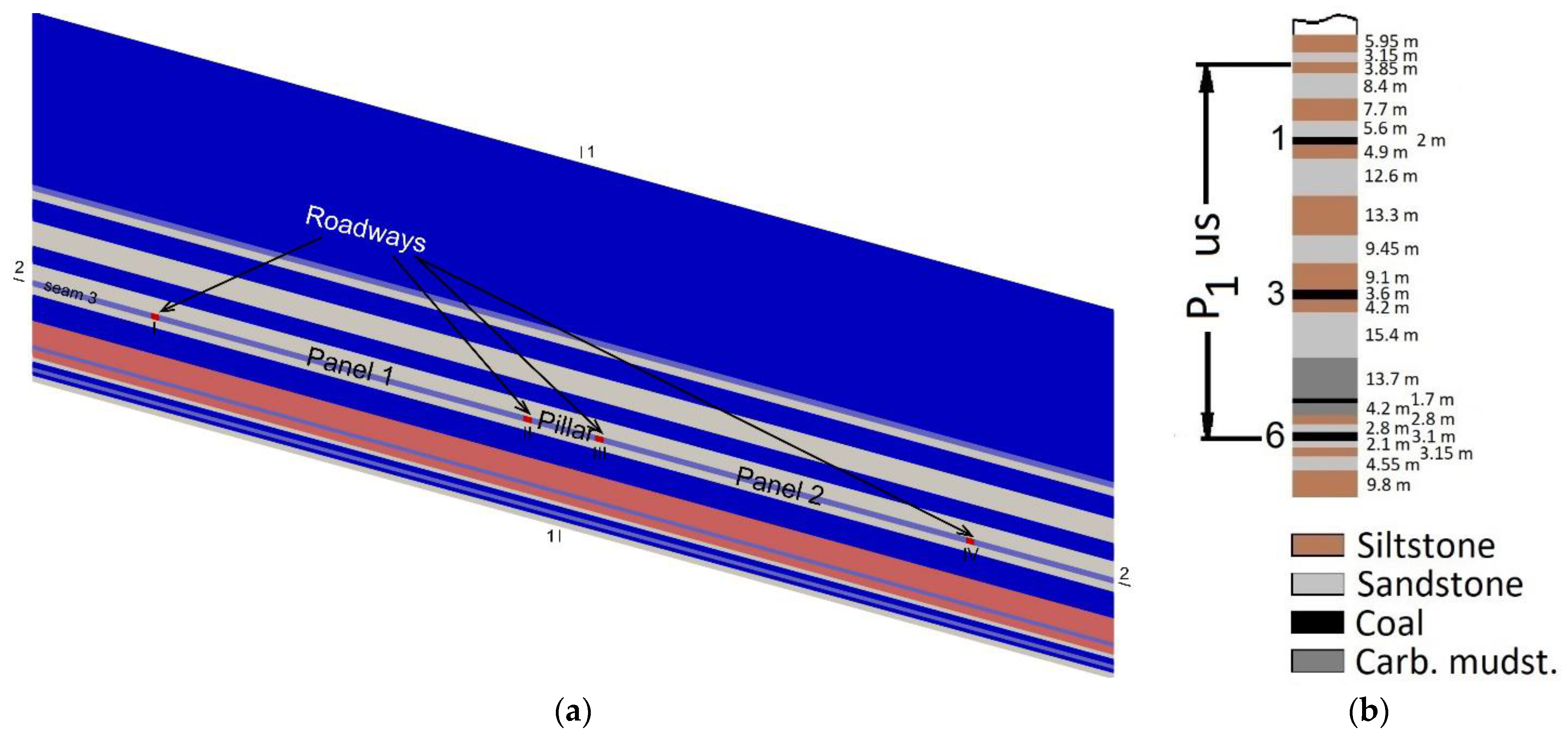
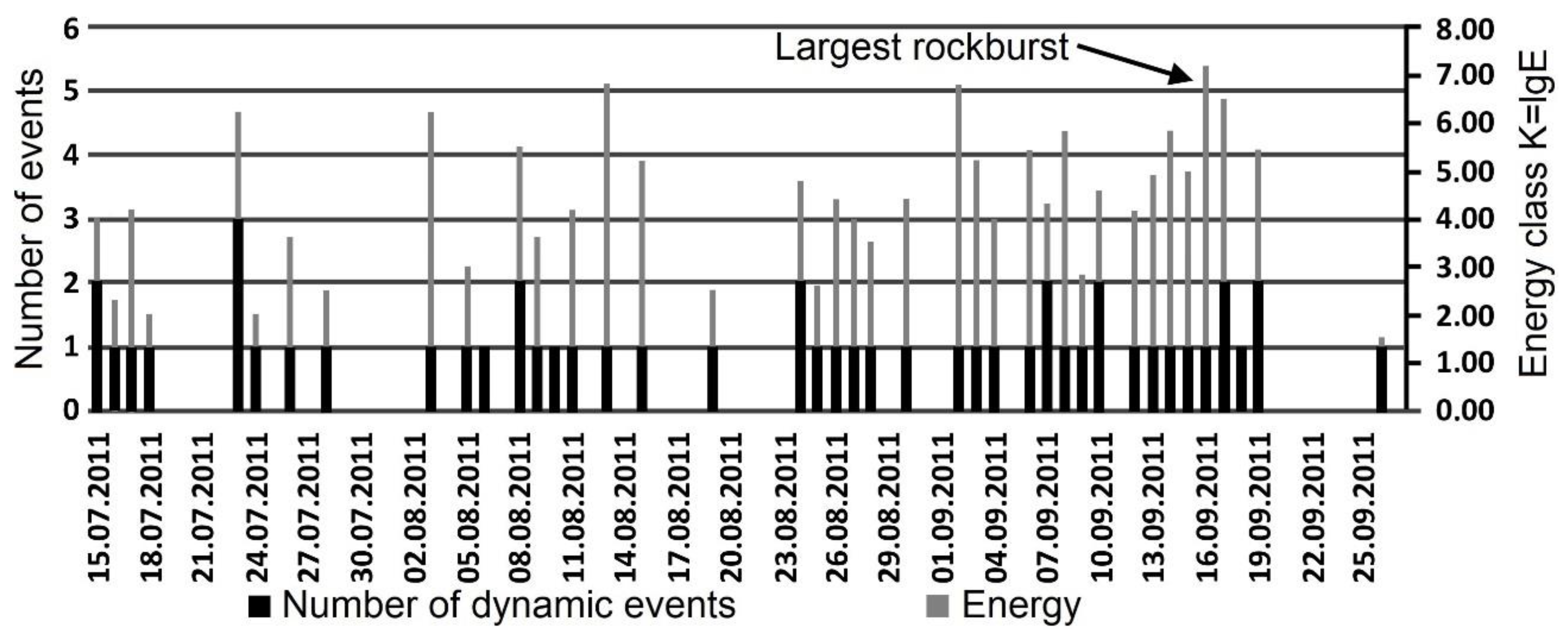

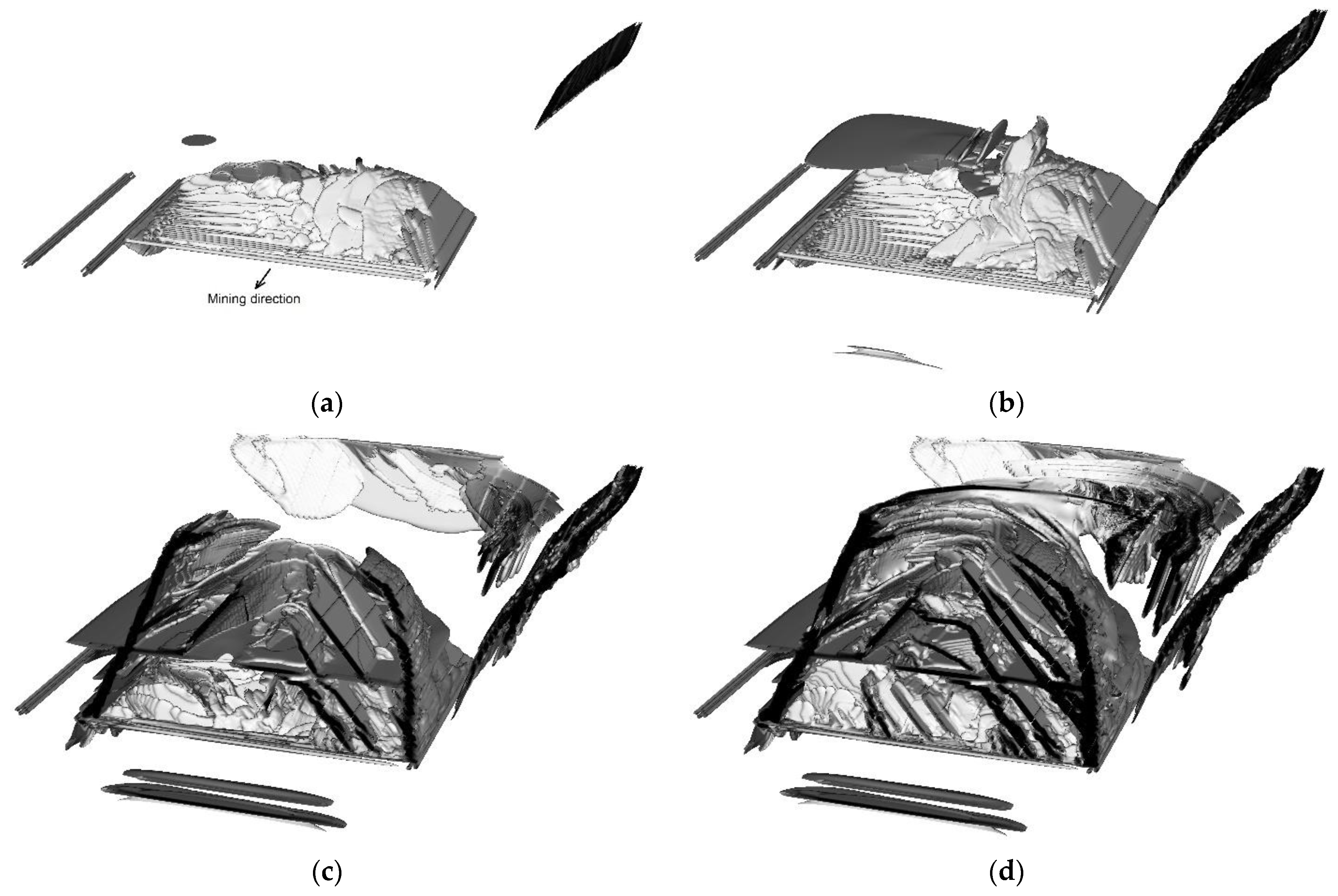

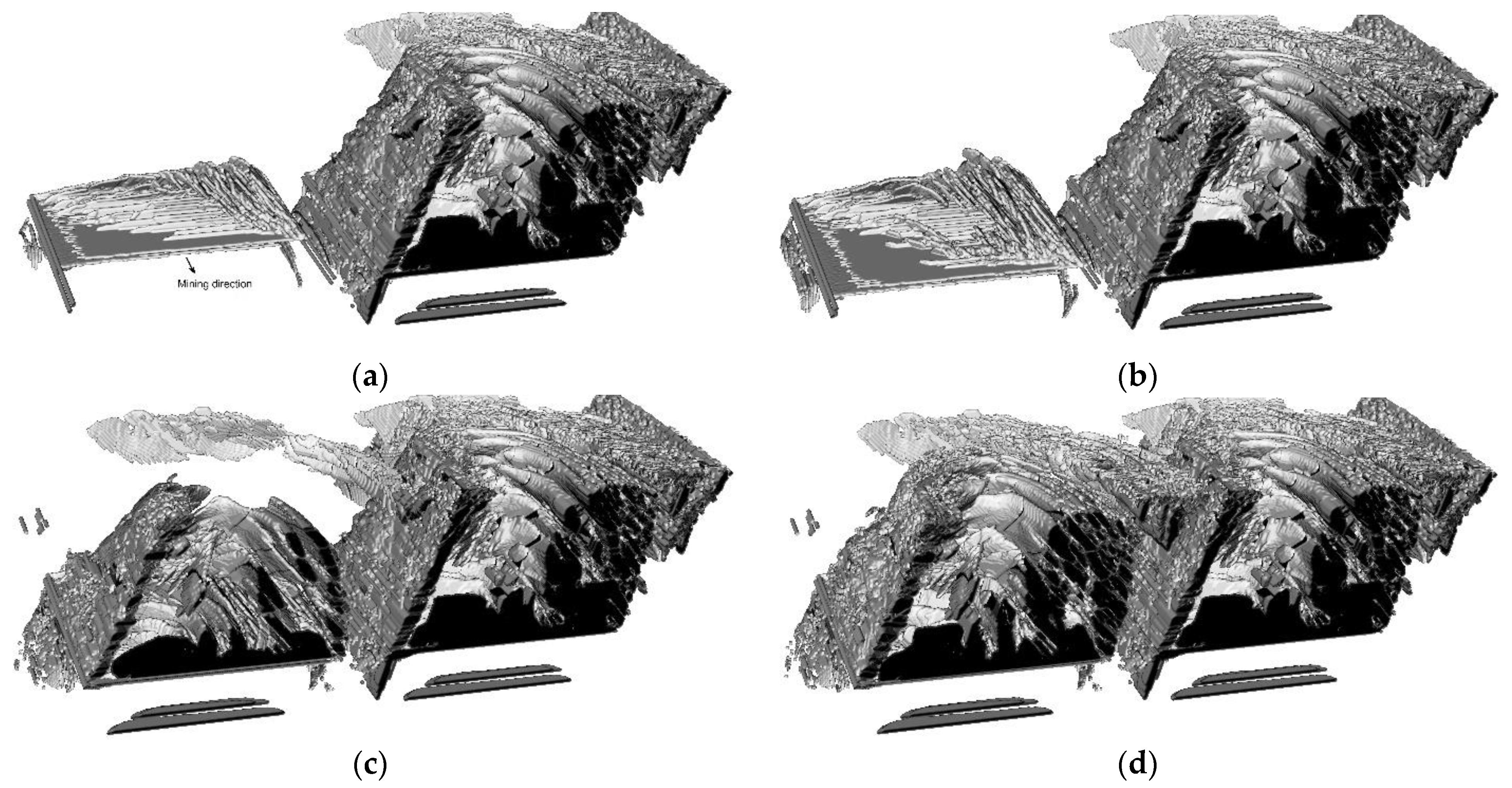

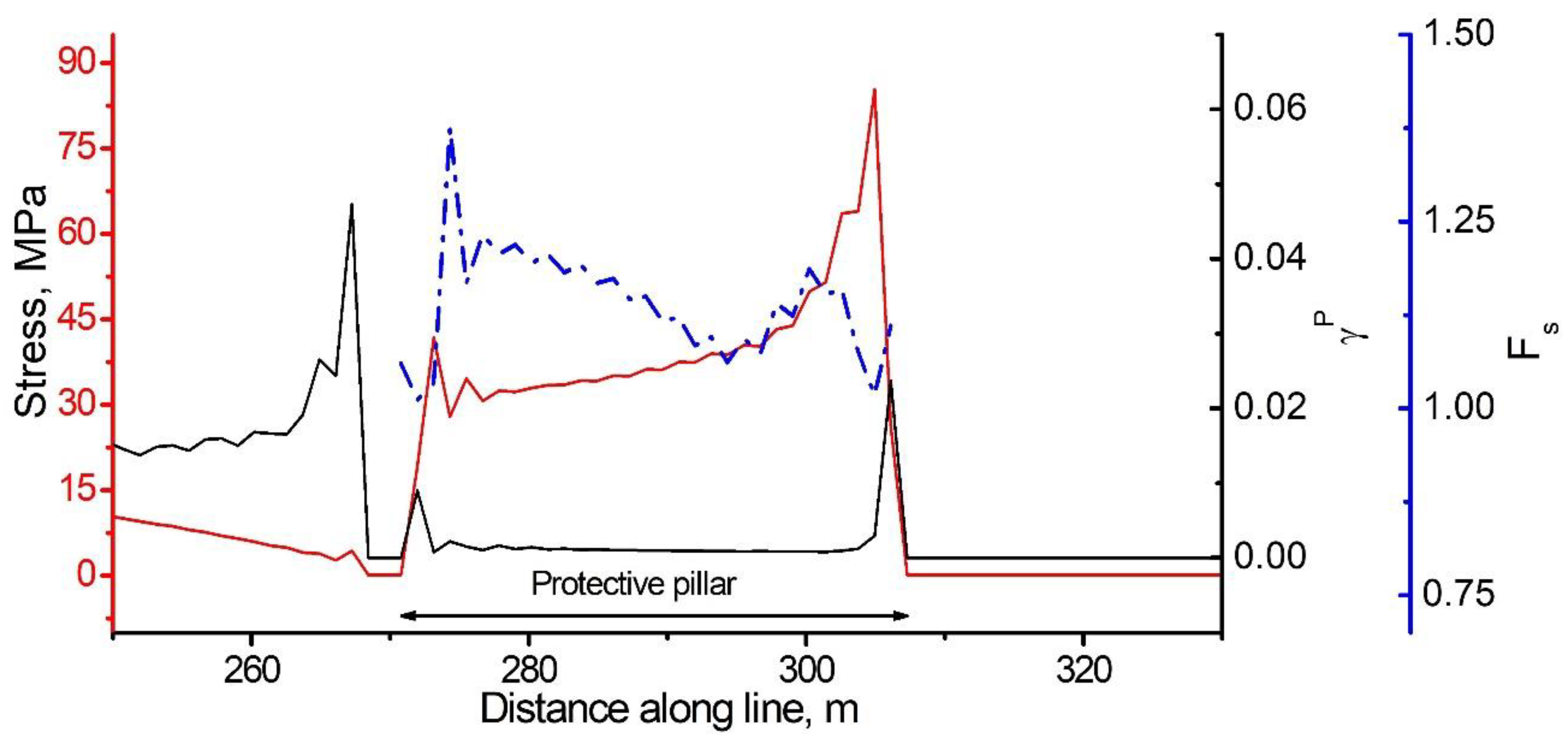

| Rock | |||||||||
|---|---|---|---|---|---|---|---|---|---|
| Sandstone | 2.54 | 12.22 | 10.43 | 22.1 | 2.82 | 3.45 | 1.34 | 0.84 | 0.08 |
| Siltstone | 2.55 | 13.18 | 9.17 | 13.92 | 1.11 | 3.03 | 1.32 | 0.81 | 0.1 |
| Carb.mudst. | 1.93 | 11.76 | 7.56 | 11.73 | 1.5 | 2.1 | 1.34 | 0.9 | 0.549 |
| Coal | 1.29 | 3.29 | 2.275 | 2.616 | 1.1 | 0.9 | 0.7 | 0.7 | 0.11 |
Publisher’s Note: MDPI stays neutral with regard to jurisdictional claims in published maps and institutional affiliations. |
© 2022 by the authors. Licensee MDPI, Basel, Switzerland. This article is an open access article distributed under the terms and conditions of the Creative Commons Attribution (CC BY) license (https://creativecommons.org/licenses/by/4.0/).
Share and Cite
Eremin, M.; Peryshkin, A.; Esterhuizen, G.; Pavlova, L.; Fryanov, V. Numerical Analysis of Pillar Stability in Longwall Mining of Two Adjacent Panels of an Inclined Coal Seam. Appl. Sci. 2022, 12, 11028. https://doi.org/10.3390/app122111028
Eremin M, Peryshkin A, Esterhuizen G, Pavlova L, Fryanov V. Numerical Analysis of Pillar Stability in Longwall Mining of Two Adjacent Panels of an Inclined Coal Seam. Applied Sciences. 2022; 12(21):11028. https://doi.org/10.3390/app122111028
Chicago/Turabian StyleEremin, Mikhail, Alexey Peryshkin, Gabriel Esterhuizen, Larisa Pavlova, and Victor Fryanov. 2022. "Numerical Analysis of Pillar Stability in Longwall Mining of Two Adjacent Panels of an Inclined Coal Seam" Applied Sciences 12, no. 21: 11028. https://doi.org/10.3390/app122111028





